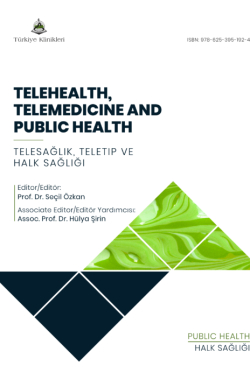Telemedicine in Physical Activity and Sports
Hacı Ahmet PEKELa
aGazi University Faculty of Sport Sciences, Department of Trainer Education, Division of Movement and Training Sciences, Ankara, Türkiye
Pekel HA. Telemedicine in physical activity and sports. In: Özkan S, ed. Telehealth, Telemedicine and Public Health. 1st ed. Ankara: Türkiye Klinikleri; 2024. p.92-5.
ABSTRACT
The relentless progression of technology, coupled with the expansion of informatics, has ushered in a multitude of advantages for physical activity and sports. These benefits encompass a broad spectrum, ranging from the utilization of advanced equipment in training to the analysis and interpretation of training observations. Notably, the outbreak of the COVID-19 pandemic precipitated a paradigm shift, mandating remote access as an indispensable mechanism for sustaining a healthy lifestyle, particularly in fields such as education. This transformation has given rise to a diverse populace, encompassing individuals seeking to preserve their well-being through physical activity and athletes engaged in remote training. Concurrently, the challenges posed by transportation constraints and restrictions have engendered solutions within the domain of sports injuries and their treatment. This evolution, facilitated by remote access, has yielded enhanced outcomes in injury management.
Keywords: Sports; physical activity; telemedicine; telehealth
Kaynak Göster
Referanslar
- Dijkstra HP, Ergen E, Holtzhausen L, Beasley I, Alonso JM, Geertsema L, et al. Remote assessment in sport and exercise medicine (SEM): a narrative review and teleSEM solutions for and beyond the COVID-19 pandemic. Br J Sports Med. 2020;54(19):1162-7. [Crossref] [PubMed] [PMC]
- Smith A. Telemedicine vs. Telehealth: What's the Difference? Chiron Health, 2015. Cited: 15 Sep 2023 [Link]
- eVisit. Telehealth vs telemedicine: definition of differences. Available: [Cited: 16 Sep 2023]. [Link]
- (Accessed 10 Nov 2023) [Link]
- Park AH, Zhong S, Yang H, Jeong J, Lee C. Impact of COVID-19 on physical activity: A rapid review. J Glob Health. 2022;12:05003. [Crossref] [PubMed] [PMC]
- (Cited: 12 Nov 2023) [Link]
- (Cited: 12 Nov 2023) [Link]
- (Cited: 12 Nov 2023) [Link]
- (Cited: 14 Nov 2023) [Link]
- (Cited: 14 Nov 2023) [Link]
- (Cited: 14 Nov 2015) [Link]
- (Cited: 15 Nov 2023) [Link]
- (Cited: 15 Nov 2023) [Link]
- Harangi-Rákos M, Pfau C, Bácsné Bába É, Bács BA, Kőmíves PM. Lockdowns and Physical Activities: Sports in the Time of COVID. Int J Environ Res Public Health. 2022;19(4):2175. [Crossref] [PubMed] [PMC]
- Link D, Anzer G. How the COVID-19 Pandemic has Changed the Game of Soccer. Int J Sports Med. 2022;43(1):83-93. [Crossref] [PubMed] [PMC]
- Currell R, Urquhart C, Wainwright P, Lewis R. Telemedicine versus face to face patient care: effects on professional practice and health care outcomes. Cochrane Database Syst Rev. 2000;(2):CD002098. Update in: Cochrane Database Syst Rev. 2015;9:CD002098. [Crossref]
- (Cited: 14 Nov 2023) [Link]
- Cited: 16 Nov. 2023 [Link]
- (Cited: 16 Nov 2023) [Link]
- (Cited: 16 Nov 2023) [Link]
- Bompa, T; Buzzichelli, C.A (2021) Theory and Methodology of Training, ISBN 9781492544814, s.2
- (Cited: 16 Nov 2023) [Link]
- (Cited: 16 Nov 2023) [Link]
- (Cited: 16 Nov 2023) [Link]
- (Cited: 16 Nov 2023) [Link]

